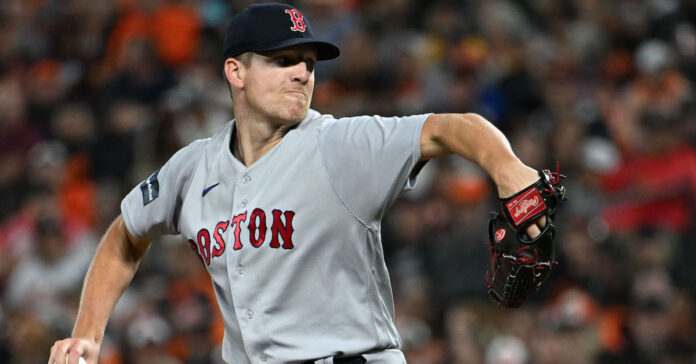
Nick Pivetta had an intriguing and largely successful season. A starter to begin the year, the veteran right-hander was shifted to Boston’s bullpen in mid-May, only to return to the rotation a few months later and finish strong. Save for a smattering of rocky outings — mostly in the early going — he was actually solid throughout. All told, the 30-year-old Victoria, British Columbia native logged a 4.04 ERA and a 3.98 FIP over 142-and-two-thirds innings, the second-highest innings mark on the club.
He was often overpowering. Opposing hitters had a .207 BA and a .221 xBA versus his array of offerings, while his 31.2% strikeout rate ranked in the 93rd percentile among big league hurlers per Baseball Savant. An in-season addition to the Red Sox righty’s repertoire was especially effective: Pivetta posted a 44.4% whiff rate and allowed just a .114 BA and a .127 xBA on his sweeper.
Pivetta, who ended up making 16 starts and 22 relief appearances on the season, discussed his 2023 performance on the final week of September.
———
David Laurila: How would you assess your season as a whole?
Nick Pivetta: “I’d say it was good. I mean, I think I’ve handled the situation well. I’ve gone out and given my best effort — I’ve competed and put everything on the line for the organization — and that’s all I really focus on. I’m always making sure that I’m doing the best I can for the team.”
Laurila: What about the quality of your stuff and the numbers that have come along with it?
Pivetta: “I don’t really pay much attention to those things. I feel like if you get caught up in all of that, you kind of lose focus. I mean, as soon as you start focusing on your ERA, your strikeout percentage, your walk rate, your innings pitched… I think that gets you away from what you need to do, which is attack hitters and throw strikes. That’s a big lesson I’ve learned, to just focus on those aspects of the game and allow the rest to dictate itself. It has turned out to be pretty good for me numbers-wise, and I’m obviously happy with that, but you still need to put a full season together.”
Laurila: Those things said, there is a metrics-based process behind the results…
Pivetta: “I honestly don’t look at that all that closely. I don’t mean to sound arrogant, but I get natural ride on my fastball. I can throw a 20-inch curveball that moves at 3,000 [rpm]. I picked up a whirlybird that is above average. I’ve been able to work on my cutter-slider. It’s really just about getting my body in the right position to allow my natural ability to take over.”
Laurila: When exactly did you add the sweeper?
Pivetta: “I had a conversation with Chris Martin about it when we were in Cleveland [in early June]. We played catch with it in the outfield and I threw some in my next relief appearance.
“So, I have two different sliders now. I have my cut slider — my harder slider — and then I have the one that registers as a sweeper. I call it a whirlybird, because that’s what everybody is calling it.”
Laurila: Why has it been effective?
Pivetta: “It takes some pressure off of my curveball. Basically, it gives me an extra pitch that, velocity-wise, plays well into my repertoire. My sweeper is 82-85 [mph] and the curveball is more 78-80. And the movement profiles are very different. One is much more vertically down, while the other is horizontally across. I try to get the vertical movement eliminated as much as possible on the whirlybird.”
Laurila: Playing your pitches off each other — how you’re sequencing them — is important…
Pivetta: “For me, a lot of it is based on the pitches I throw, how I go about attacking hitters, and what they’re maybe showing me that day. It’s not so much about how the pitches play off each other, per se. You can always talk about tunneling, but I think it’s more the quality of the pitches and where they’re executed. I think that’s more important in a sense. I’m not too focused on the usage or how they’re going to tunnel so as much as, ‘Am I getting my pitches in the zone? Am I getting swings and misses? Am I getting outs?’”
Laurila: What is the plan going forward? Are there specific things you’re going to focus on in the offseason?
Pivetta: “I want to work on my sweeper, making it more consistent. Other than that, I’ll basically stick to what I need to work on, based on what I didn’t do well this year — especially earlier on. My velo was down early on. My mechanics were off. I wasn’t using my lower half properly, so I was losing a lot of power. Fortunately I was able to make some mechanical adjustments and get my power back, get my easy velo back. Everything else kind of goes from there. The ground up is the most important thing for me. When my mechanics are good, everything else is going to be good.”

